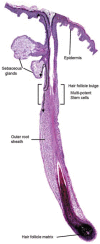Stem Cell Therapy: A New Treatment for Burns?
- PMID: 27721328
- PMCID: PMC4060129
- DOI: 10.3390/ph4101355
Stem Cell Therapy: A New Treatment for Burns?
Abstract
Stem cell therapy has emerged as a promising new approach in almost every medicine specialty. This vast, heterogeneous family of cells are now both naturally (embryonic and adult stem cells) or artificially obtained (induced pluripotent stem cells or iPSCs) and their fates have become increasingly controllable, thanks to ongoing research in this passionate new field. We are at the beginning of a new era in medicine, with multiple applications for stem cell therapy, not only as a monotherapy, but also as an adjunct to other strategies, such as organ transplantation or standard drug treatment. Regrettably, serious preclinical concerns remain and differentiation, cell fusion, senescence and signalling crosstalk with growth factors and biomaterials are still challenges for this promising multidisciplinary therapeutic modality. Severe burns have several indications for stem cell therapy, including enhancement of wound healing, replacement of damaged skin and perfect skin regeneration - incorporating skin appendages and reduced fibrosis -, as well as systemic effects, such as inflammation, hypermetabolism and immunosuppression. The aim of this review is to describe well established characteristics of stem cells and to delineate new advances in the stem cell field, in the context of burn injury and wound healing.
Keywords: burn; regenerative medicine; stem cells; tissue engineering.
Figures




References
-
- Atiyeh B., Costagliola M. Cultured epithelial autograft (CEA) in burn treatment: Three decades later. Burns. 2007;33:405–413. - PubMed
-
- Jones I., Currie L., Martin R. A guide to biological skin substitutes. Br. J. Plast. Surg. 2002;55:185–193. - PubMed
-
- Zhang C.P., Fu X.B. Therapeutic potential of stem cells in skin repair and regeneration. Chin. J. Traumatol. 2008;11:209–221. - PubMed
-
- Lataillade J.J., Doucet C., Bey E., Carsin H., Huet C., Clairand I., Bottollier-Depois J.F., Chapel A., Ernou I., Gourven M., et al. New approach to radiation burn treatment by dosimetry-guided surgery combined with autologous mesenchymal stem cell therapy. Regen. Med. 2007;2:785–794. - PubMed
-
- Weil B.R., Markel TA., Herrmann J.L., Abarbanell A.M., Kelly M.L., Meldrum D.R. Stem cells in sepsis. Ann. Surg. 2009;250:219–227. - PubMed
Publication types
LinkOut - more resources
Full Text Sources
Other Literature Sources

